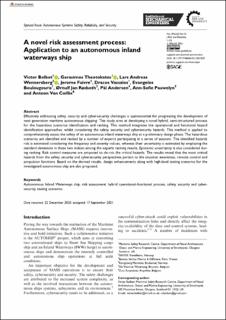| dc.contributor.author | Bolbot, Victor | |
| dc.contributor.author | Theotokatos, Gerasimos | |
| dc.contributor.author | Wennersberg, Lars Andreas Lien | |
| dc.contributor.author | Faivre, Jérôme | |
| dc.contributor.author | Vassalos, Dracos | |
| dc.contributor.author | Boulougouris, Evangelos | |
| dc.contributor.author | Rødseth, Ørnulf Jan | |
| dc.contributor.author | Andersen, Pål | |
| dc.contributor.author | Pauwelyn, Ann-Sofie | |
| dc.contributor.author | Van Coillie, Antoon | |
| dc.date.accessioned | 2022-03-31T13:07:16Z | |
| dc.date.available | 2022-03-31T13:07:16Z | |
| dc.date.created | 2021-11-11T13:44:29Z | |
| dc.date.issued | 2021 | |
| dc.identifier.citation | Proceedings of the Institution of Mechanical Engineers. Part O, Journal of risk and reliability. 2021, . | en_US |
| dc.identifier.issn | 1748-006X | |
| dc.identifier.uri | https://hdl.handle.net/11250/2988897 | |
| dc.description.abstract | Effectively addressing safety, security and cyber-security challenges is quintessential for progressing the development of next generation maritime autonomous shipping. This study aims at developing a novel hybrid, semi-structured process for the hazardous scenarios identification and ranking. This method integrates the operational and functional hazard identification approaches, whilst considering the safety, security and cybersecurity hazards. This method is applied to comprehensively assess the safety of an autonomous inland waterways ship at a preliminary design phase. The hazardous scenarios are identified and ranked by a number of experts participating in a series of sessions. The identified hazards risk is estimated considering the frequency and severity indices, whereas their uncertainty is estimated by employing the standard deviations in these two indices among the experts ranking results. Epistemic uncertainty is also considered during ranking. Risk control measures are proposed to de-risk the critical hazards. The results reveal that the most critical hazards from the safety, security and cybersecurity perspectives pertain to the situation awareness, remote control and propulsion functions. Based on the derived results, design enhancements along with high-level testing scenarios for the investigated autonomous ship are also proposed. | en_US |
| dc.language.iso | eng | en_US |
| dc.publisher | Sage | en_US |
| dc.rights | Navngivelse 4.0 Internasjonal | * |
| dc.rights.uri | http://creativecommons.org/licenses/by/4.0/deed.no | * |
| dc.subject | testing scenarios | en_US |
| dc.subject | security and cyber-security | en_US |
| dc.subject | safety | en_US |
| dc.subject | hybrid operational-functional process | en_US |
| dc.subject | risk assessment | en_US |
| dc.subject | Autonomous Inland Waterways ship | en_US |
| dc.title | A novel risk assessment process: Application to an autonomous inland waterways ship | en_US |
| dc.type | Peer reviewed | en_US |
| dc.type | Journal article | en_US |
| dc.description.version | publishedVersion | en_US |
| dc.rights.holder | The authors | en_US |
| dc.source.pagenumber | 23 | en_US |
| dc.source.journal | Proceedings of the Institution of Mechanical Engineers. Part O, Journal of risk and reliability | en_US |
| dc.identifier.doi | 10.1177/1748006X211051829 | |
| dc.identifier.cristin | 1953699 | |
| dc.relation.project | EC/H2020/815012 | en_US |
| cristin.ispublished | true | |
| cristin.fulltext | original | |
| cristin.qualitycode | 1 | |

